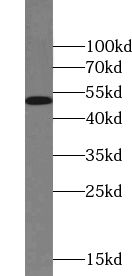Products
ZFP36L2 antibody
| Synonyms: | mRNA decay activator protein ZFP36L2|Butyrate response factor 2|EGF-response factor 2 (ERF-2)|TPA-induced sequence 11d|Zinc finger protein 36 antibody, C3H1 type-like 2 (ZFP36-like 2)|ZFP36L2|ERF2|RNF162C|TIS11D antibody | ||
| Catalogue No.: | FNab09625 | Reactivity: | Human, Mouse, Rat |
| Host: | Rabbit | Tested Application: | ELISA, WB |
| Clonality: | polyclonal | Isotype: | IgG |
| Size | Price |
|---|---|
| 100µg | Inquiry |
- SPECIFICATIONS
- FIGURES
- CONDITIONS
- FAQS
- Product Name
- ZFP36L2 antibody
- Catalogue No.
- FNab09625
- Size
- 100μg
- Form
- liquid
- Purification
- Immunogen affinity purified
- Purity
- ≥95% as determined by SDS-PAGE
- Clonality
- polyclonal
- Isotype
- IgG
- Storage
- PBS with 0.02% sodium azide and 50% glycerol pH 7.3, -20℃ for 12 months(Avoid repeated freeze / thaw cycles.)
- Immunogen
- zinc finger protein 36, C3H type-like 2
- Alternative Names
- mRNA decay activator protein ZFP36L2|Butyrate response factor 2|EGF-response factor 2 (ERF-2)|TPA-induced sequence 11d|Zinc finger protein 36 antibody, C3H1 type-like 2 (ZFP36-like 2)|ZFP36L2|ERF2|RNF162C|TIS11D antibody
- UniProt ID
- P47974
- Observed MW
- 51 kDa
- Tested Applications
- ELISA, WB
- Recommended dilution
- WB: 1:200-1:2000
 HepG2 cells were subjected to SDS PAGE followed by western blot with FNab09625(ZFP36L2 antibody) at dilution of 1:500
HepG2 cells were subjected to SDS PAGE followed by western blot with FNab09625(ZFP36L2 antibody) at dilution of 1:500
- Background
- mRNA-binding protein that plays a key role in self-renewal of erythroid cells in response to glucocorticoids. Specifically binds to the AU-rich element(ARE) in the 3'-UTR of target mRNAs, promoting their deadenylation and degradation(PubMed:14981510). Specifically expressed in burst-forming unit-erythroid(BFU-E) progenitors in response to glucocorticoids and acts as a negative regulator of erythroid cell differentiation: promotes self-renewal of erythroid cells by binding mRNAs that are induced or highly expressed during terminal erythroid differentiation and promotes their degradation, preventing erythroid cell differentiation. Down-regulated during erythroid differentiation from the BFU-E stage, stabilizing mRNAs required for terminal differentiation(By similarity).
How many times can antibodies be recycled?
First, usually it's not suggested to recycle antibodies. After use, buffer system of antibodies has changed. The storage condition of recycled antibodies for different customers also varies. Thus, the performance efficiency of recycled antibodies can’t be guaranteed. Besides, FineTest ever conducted the antibody recycling assay. Assay results show recycling times of different antibodies also varies. Usually, higher antibody titer allows more repeated use. Customers can determine based on experimental requirements.
Notes: After incubation, we recycle rest antibodies to centrifuge tube and store at 4℃. High titer antibodies can be stored for a minimum of one week. Reuse about three times.
What are components of FineTest antibody buffer?
Components of FineTest antibody buffer are usually PBS with proclin300 or sodium azide, BSA, 50% glycerol. Common preservative is proclin300 or sodium azide, which is widely applied in the lab and industry.
How about the storage temperature and duration of FineTest antibodies?
Most antibodies are stored at -20℃. Directly-labeled flow cytometry antibodies should be stored at 2 - 8℃. The shelf life is one year. If after sales issues for purchased antibodies appear, return or replacement is available. Usually, antibodies can be still used after the one-year warranty. We can offer technical support services.
Is dilution required for FineTest antibodies? What’s the dilute solution?
Directly-labeled flow cytometry antibodies are ready-to-use without dilution. Other antibodies are usually concentrated. Follow the dilution ratio suggested in the manual. Dilute solution for different experiments also varies. Common antibody dilution buffers are acceptable(e.g. PBST, TBST, antibody blocking buffer).
How to retrieve antibodies for immunohistochemistry?
Common retrieval buffers: Tris-EDTA Buffer(pH 9.0); Citrate Buffer(pH 6.0)
Heat induced antibody retrieval:
Method 1: Water-bath heating: Put the beaker with retrieval buffer and slide in the boiling water bath. Keep the boiling state for 15min. Naturally cool to room temperature;
Method 2: Microwave retrieval: Put the beaker with retrieval buffer and slide in the microwave oven. Heat at high power for 5min, Switch OFF for 3min, Heat at medium power for 5min. Naturally cool to room temperature.
How to choose secondary antibodies?
(1) Secondary antibodies react with primary antibodies. Thus, secondary antibodies should be against host species of primary antibodies. E.g. If the primary antibody is derived from rabbit, the relevant secondary antibody should be against rabbit. E.g. goat anti rabbit or donkey anti rabbit.
(2) Choose secondary antibody conjugates according to the experimental type, e.g. ELISA, WB, IHC etc. Common enzyme conjugated secondary antibodies are labelled by HRP, AP etc. Fluorescin or dye labelled secondary antibodies are applied in immunofluorescence and flow cytometry(e.g. FITC, Cy3).
